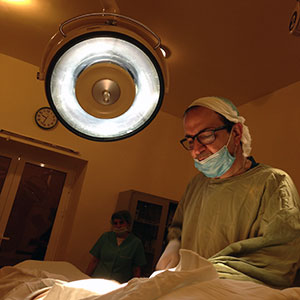(EditorŌĆÖs Note: This story was written by Allison A. Curley ŌĆÖ04)
People usually come to plastic surgeon Ricardo Rodriguez ŌĆÖ76 to eliminate excess fat ŌĆö but he will tell you that the lumpy stuff is not all bad. In fact, removing a patientŌĆÖs fat during liposuction and injecting it back into another area of the body produces rejuvenated, younger-looking skin.
The success of these ŌĆ£fat graftsŌĆØ is due to the restorative stem cells found abundantly in fat tissue. But the real power of these stem cells is not in cosmetic proceduresŌĆö itŌĆÖs in their recently discovered ability to treat damaged tissue.
ŌĆ£The cells have huge potential to revolutionize medicine,ŌĆØ said Rodriguez, who has been developing techniques to help patients with injuries like severe burns and radiation injury.

Ricardo Rodriguez ŌĆÖ76 received a Maryland Stem Cell Research Fund grant to study the fate of adipose stem cells.
Rodriguez, who obtained his medical degree from the University of Wisconsin in 1980, has performed both cosmetic and reconstructive surgeries for more than 25 years. While using fat grafts as a ŌĆ£fillerŌĆØ in cosmetic procedures, he was surprised to find that they improved skin appearance. Then, at a 2007 plastic surgery conference, Rodriguez learned that fat grafts could be used to heal tissue damaged by radiation.
ŌĆ£That was almost like saying ŌĆśwe breathe water,ŌĆÖ it was so nonsensical,ŌĆØ he explained, both because irradiated tissue is severely damaged and because, at the time, fat had a reputation as a very unreliable graft material.
It turns out, though, that the stem cells that reside in the small blood vessels of fat (adipose) tissue act as an internal repair system.
Over the next several years, Rodriguez spent his time outside the operating room learning all he could about stem cells and irradiated tissue. He developed surgical protocols to inject a concentrated form of fat stem cells into patients, and as president of the International Cellular Medicine Society, he is helping to standardize the processing methods used to isolate the cells in order to ensure patient safety.
Unfortunately, bringing this technology into the clinic has lagged, said Rodriguez, because the Food and Drug Administration requires stem cells ŌĆö even ones removed from and inserted back into a patient within the same procedure ŌĆö to be regulated like a drug.
This has led to a lot of ŌĆ£legal roadblocks,ŌĆØ he explained, that are currently preventing U.S. clinicians from using the technology. Rodriguez has recruited Mary Chirba ŌĆÖ76 (his friend since 51Ęń┴„, and now a professor at Boston College Law School) to devise legal strategies to deal with the regulatory roadblocks.
Until these regulatory issues are resolved, Rodriguez is using his skills to help international patients. He was invited to teach other surgeons to perform both basic fat grafts and the concentrated stem cell technique on an ŌĆ£incredibly fulfillingŌĆØ five-day trip to Armenia in 2012, where he operated on 14 patients, the majority of whom were young girls with severe burns. In October, Rodriguez returned for another round of surgeries to help patients and educate more physicians.
Along with Jeff Bulte, an MRI imaging researcher at Johns Hopkins, Rodriguez has been awarded a Maryland Stem Cell Research Fund grant to study the fate of adipose stem cells that are injected into radiation-damaged breast tissue. The trial, in which stem cells are labeled with special molecules called fluorocarbons for tracking purposes, will provide information about how the cells behave, where they go, and how safe they are, said Rodriguez.
While he enjoys performing cosmetic surgeries, ŌĆ£sometimes, being a plastic surgeon, you wonder, ŌĆśis what IŌĆÖm doing worth anything?ŌĆÖŌĆØ Rodriguez said. ŌĆ£The minute I discovered stem cells, it was like a fairy tale come true. There is such an enormous opportunity to help so many patients.ŌĆØ
